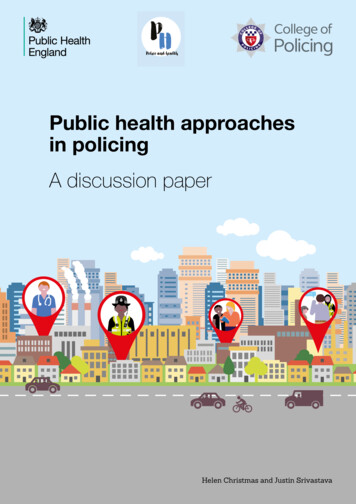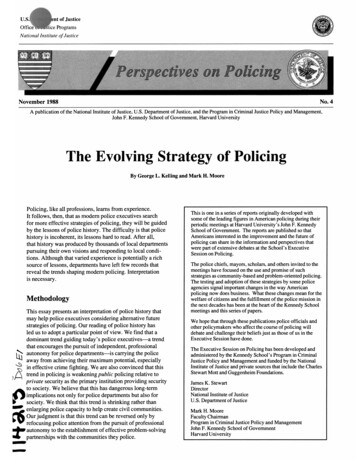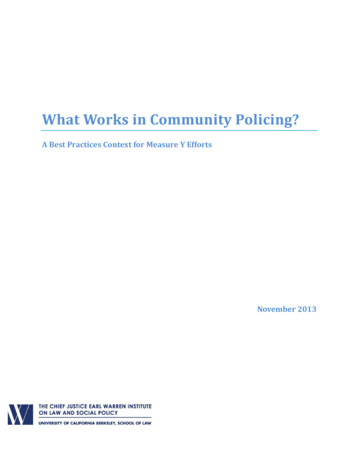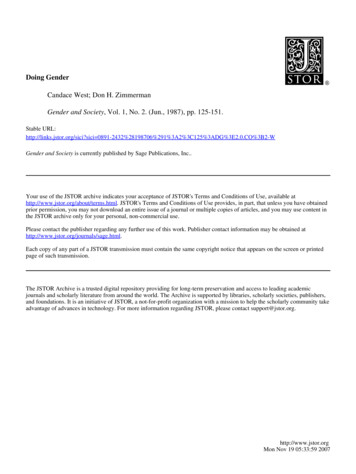
Transcription
May 2016UnderstandingGender-Biased Policing:Police Misconduct, Domestic Violence,and Sexual AssaultIn cities and states across the country, advocates and activists are calling for an endto discriminatory policing against people of color, women, LGBT people, people withdisabilities, and immigrants. They are working to reform police practices that put livesin danger and undermine our system of justice.In this era of reform, new attention must be paid to the problem of gender-biasedpolicing, specifically the improper, discriminatory, and unlawful ways in which lawenforcement officials respond to or commit crimes involving domestic violence andsexual assault. Voices across the country—including the U.S. Department of Justice,anti-violence and civil rights advocates, and law enforcement leaders—have soundedthe alarm on police practices and policies that are premised on pernicious genderstereotypes about survivors of violence. Gender-biased policing not only denies victims ofdomestic violence and sexual assault the equal protection of the law and protection fromharm, but also destroys trust between law enforcement and the communities they serve.This briefing paper defines and provides examples of gender-biased policing, suggestsways for police departments to address bias that may underlie certain practices, andpolicies and offers steps advocates can take to work toward police reform.
Defining Gender-Biased PolicingGender-biased policing is a term used to capture certain law enforcement practices thatare rooted in (conscious or unconscious) gender stereotypes, have a discriminatory anddisproportionate impact on women, and subject women and LGBT people to harassment,violence, or hostility by police officers.Gender-biased policing occurs most often in cases of domestic violence andsexual assault. Examples of gender-biased policing include: Failing to properly investigate or misclassifying domestic violence and sexualassault complaints before a full investigation is conducted because of the victim’sgender, sexual orientation, dress, sexual history, criminal history, emotional state,or appearance; Failing to test sexual assault kits in a timely fashion; Discounting intimate partner violence against LGBT individuals because it iscommitted against a same-sex partner; Harassing transgender people, particularly trans women of color, because of theirgender identity; Failing to hold police officers accountable and permitting them to remain inpositions of power when they have committed domestic violence or have used theirposition to sexually harass or assault.The Prevalence of Gender-Biased PolicingThere is little doubt that many police officers across the country do their jobs withprofessionalism, integrity, and care. At the same time, investigations by the Departmentof Justice, advocates, and others have revealed the chronic and systemic patterns of biasthat exist in police departments when individuals, predominantly women but also somemen, seek police assistance in domestic violence and sexual assault cases.The following examples of gender-biased policing are only the tip of the iceberg. The Detroit Police Department for years failed to process more than 11,000rape kits. This occurred, in part, because of police reports that questioned thevictims’ credibility; rape survivors were commonly assumed to be prostitutes andadolescents were assumed to be lying.12
The Prevalence of Gender-Biased Policing continued. The Metropolitan Police Department of Washington D.C. engaged in practices thatresulted in misclassified or undocumented sexual assault cases. There were nopolice incident reports for a substantial number of cases recorded by a hospitalas having been reported to the police and officers utilized poor interviewingtechniques including one who went so far as to ask a rape victim if her assailantwas good at oral sex.2 The Missoula (Montana) Police Department failed to employ key investigativepractices that would have safeguarded potential evidence and protected therights of victims. The MPD did not obtain timely and credible statements fromwitnesses and suspects; engaged in investigative and interview practices thatoften discouraged victims from participating in investigations; made numerousstatements reflecting stereotypes such as telling a woman who was gang rapedthat it “was probably just a drunken night and a mistake” and repeatedly askingher if she had said no and to reenact how she had said no; failed to institute anypolicy guidance on responding to sexual assault and instead left the conduct ofinvestigations entirely subject to the discretion of MPD detectives.3 The New Orleans Police Department systematically failed to properly investigatedomestic violence cases, did not address police harassment of LGBT individuals,and underreported the number of rape crimes that occurred in the city. Forexample, the NOPD reported that there were more homicides than rapes despitethe fact that the opposite is true in most cities across the country; regularly shutdown investigations of sex crimes by classifying sexual assault complaints as“miscellaneous” or “non-criminal” cases because the victim had a history ofmental disability or prostitution or lied about being arrested in the past; and didnot provide specific guidance on how to investigate domestic violence cases andassigned only three detectives to the Domestic Violence Unit, relying on untraineddistrict officers to carry out the majority of the casework.4 The Philadelphia Police Department downgraded thousands of rapes and othersex crimes to a noncriminal category. In doing so, the PPD precluded a full andcomplete investigation of the crime and victims were never advised that theircomplaints had been shelved.53
The Prevalence of Gender-Biased Policing continued.Gender-biased policing also includes sexual assault or domestic violencecommitted by police officers that goes unpunished or is ignored within the lawenforcement agency.Police departments and the federal government do not consistently track this problem,but there is no doubt it is a serious issue in many departments. In fact, a report foundthat sexual misconduct was the second most frequently reported form of policemisconduct.⁶ The Puerto Rico Police Department rarely took action when their own officerscommitted domestic violence, allowing 84 officers who had been arrested two ormore times for domestic violence to remain active on the force.⁷ The Associated Press, in a yearlong investigation of sexual misconduct by lawenforcement, uncovered 1,000 officers who lost their badges in a six-yearperiod for rape and other sexual assault. AP concluded that the number wasunquestionably an undercount because it represented only officers whose licenseswere revoked and not all states take such action. Additionally, some statesoffered no records because they have no statewide system to decertify officers formisconduct. Even among states that provided records, some reported no officersremoved for sexual misconduct even when cases were identified in news stories orcourt records. Lawyers and police chiefs told the AP that some departments remainsilent about improprieties, allowing officers to resign, keep their certification, orswitch to other jobs.⁸These cases and investigations, which barely scratch the surface, demonstrate thatgender-biased policing is a significant problem in police departments across the country.4
The Impact of Gender-Biased Policing: PerpetuatingViolence, Undermining Our Criminal Justice SystemAlmost20% ofwomen1.7% ofmenand aboutNearly a quarterof womenexperience domesticviolence in their lifetimehave experienced rape intheir lifetimes9More thanWomen ofcolor and ionatelyhigh rates of domesticviolence and sexualassault11are survivors of domesticviolence every year1044%of bisexual61% womenCalls regardingof lesbianwomendomestic violenceconstitute theandsingle largestcategory of callsreceived by policedepartments, making uphalf of all calls in somecommunities12have experienced rape, physicalviolence, and/or stalking by anintimate partner135
The Impact of Gender-Biased Policing continued.When police officers rely on outdated and discredited stereotypes to shame or dismissvictims and fail to fully investigate a claim of sexual violence, those officers undermineefforts to end violence by discouraging victims from coming forward and allowing abusersto continue to commit crimes with impunity.The experience of gender-biased policing causes tremendous and rippling damage in thelives of victims, families, and entire communities. When officers commit sexual assaults ordomestic violence yet remain on the force or go unpunished, it delegitimizes the authority ofthe law enforcement agency (often in communities where tensions may already exist) andcan strain and shatter the community’s confidence and trust in the criminal justice system.When survivors of sexual violence remain silent for fear of being revictimized by lawenforcement officers, the violence can escalate and lead to homicide of the victim aswell as children, family members, and responding law enforcement officers.14Gender-biased policing of domestic violence and sexual assault cases perpetuates thecycle of violence, harms individuals and families, destabilizes communities, underminesthe criminal justice system, and puts lives at risk.Two recent surveys revealed that:88%andbelieved that police “sometimes”or “often” do not believe victims orblamed victims for the violence33%of victims83%reported that police “sometimes”or “often” do not take allegations ofsexual violence seriously15andfelt less safe after calling the police24%of womenreported that they would notcall the police in the future fordomestic violence166
Our Federal Laws Prohibit Gender-Biased PolicingThe United States ConstitutionThe Equal Protection Clause of the U.S. Constitution prohibits selective or discriminatoryenforcement of the law based on a prohibited ground—including sex, race, and nationalorigin. Law enforcement practices that systematically fail to protect certain communitiesor fail to treat some crimes (such as domestic violence or sexual assault) as seriously asother crimes violate the equal protection guarantee.17The Due Process Clause imposes a duty on law enforcement where a police officercreated or knew of a dangerous situation and affirmatively increased the victim’s riskof danger.18 Courts have found violations of due process where law enforcement officerscommitted sexual violence in the course of official duty,19 implicitly but affirmativelycondoned domestic violence,20 or subjected a victim to heightened risk of sexual violenceas a result of police action.21Federal StatutesPolice departments frequently receive federal funding through the Safe Streets Act,22and the Violence Against Women Act.23 These laws prohibit discrimination based on sexand other grounds, including law enforcement practices that disparately impact women.In addition, Title VI of the Civil Rights Act of 1964 prohibits recipients of federal fundingfrom discriminating based on race or national origin, which can apply in cases involvingpolice discrimination against victims of domestic or sexual violence who are racialminorities, immigrants, and/or limited English proficient individuals.24Additionally, the Department of Justice is authorized, pursuant to the Violent CrimeControl and Law Enforcement Act of 1994 (Section 14141),24 to investigate policedepartments for engaging in a pattern or practice of conduct that would violate victims’rights to equal protection, due process, or non-discrimination under federal laws suchas the Safe Streets Act.7
Taking Steps to Stop Gender-Biased PolicingEliminating gender bias in law enforcement is possible. The efforts to end this type ofdiscriminatory policing received a major lift when, in December 2015, the Department ofJustice released Guidance on identifying and preventing gender bias in law enforcementresponse to sexual assault and domestic violence.26 But there is much more to do. Activists,concerned members of the community, civil rights and anti-violence organizations, lawenforcement officials, and others can work together in the following ways: Meet with leaders of law enforcement agencies to ensure that every agency has: Clear, written, updated policies on handling sexual assault and domestic violencecrimes so that victims are treated with respect and cases are properly classifiedand thoroughly investigated; Trauma-informed, regular training for officers about implicit biases effective policeresponses to sexual assault and domestic violence crimes; Systems of accountability in place to ensure that officers follow policies and areboth promoted and penalized according to their performance; An effective procedure in place for holding officers accountable if they commitsexual assaults or domestic violence and written policies that proactively addresssuch incidents, including reporting to the state licensing board, prosecutor’s office,internal affairs, and/or other relevant agency; Mechanisms to collect, review, and share data on how sexual assault and domesticviolence cases were investigated and resolved, and the incidence of and responsesto domestic violence and sexual assaults committed by police officers. Ensure that any investigation of police practices or police misconduct, by theDepartment of Justice or state, local or independent agencies or civilian oversightbodies, includes an examination of both law enforcement response to domesticviolence and sexual assault cases and domestic violence and sexual assaultcommitted by police officers. Organize roundtables to discuss with community members and law enforcement howpolice departments can integrate the principles outlined in the Department of JusticeGuidance on “Identifying and Preventing Gender Bias in Law Enforcement Response toSexual Assault and Domestic Violence,” into their policies and practices.8
ConclusionAcross the country, community members and groups, governments, public institutions,and law enforcement leaders and agencies are engaging in serious and substantialefforts to improve the practice and culture of policing. Reforming the current systemmeans demonstrating legitimacy and building trust between law enforcement and thecommunities they serve and protect. This can only happen when discriminatory policingis identified, acknowledged, and rooted out.Gender-biased policing is discriminatory policing. It is a form of police misconductthat re-traumatizes the victim, undermines public safety, and destroys trust betweenlaw enforcement and the broader community. And because women of color aredisproportionately affected by sexual assault and domestic violence, the perceptionand reality of racial bias in policing is also ever-present in many instances of genderbiased policing.But we can end discriminatory policing. We can bring it out of the shadows and intofocus, and ensure that survivors of domestic violence and sexual assault, and theirfamilies and communities, receive justice and dignity.Resources:PDFDepartment of Justice Guidance onIdentifying and Preventing GenderBias in Law EnforcementPDFhttp://1.usa.gov/1ZaiHiePDFResponses From The Field SexualAssault, Domestic Violence, andPolicing (Highlights & Full t of Justice Identifying AndPreventing Gender Bias ResourcesPDFhttp://1.usa.gov/1XxvPMmUsing the DOJ Guidance as a Tool toReform Gender-Biased gFor more information:Sandra ParkLenora LapidusVania LeveilleSenior Staff AttorneyACLU Women’s Rights Projectspark@aclu.orgDirectorACLU Women’s Rights Projectllapidus@aclu.orgSenior Legislative CounselACLU Washington Legislative Officevleveille@aclu.org9
References1 Rebecca Campbell et al., The Detroit Sexual Assault Kit (SAK) Action Research Project (ARP), Final Report (2015), available 0.pdf.2 Human Rights Watch, Capitol Offense: Police Mishandling of Sexual Assault Cases in the District of Columbia (2013), available us0113ForUpload 0.pdf.3 Civ. Rts. Div., U.S. Dep’t of Justice, The United States’ Investigation of the Missoula Police Department (2013), available egacy/2013/05/22/missoulapdfind 5-15-13.pdf.4 Civ. Rts. Div., U.S. Dep’t of Justice, Investigation of the New Orleans Police Department (2011), available egacy/2011/03/17/nopd report.pdf.5 Women’s Law Project, Statement of Carol E. Tracy, Senate Judiciary Committee, Subcommittee on Crime and Drugs, hearing on Rape in theUnited States: The Chronic Failure to Report and Investigate Rape Cases (2010), available athttp://www.womenslawproject.org/testimony/UCR Rape Testimony091410.pdf.6 Nat’l Police Misconduct Statistics And Reporting Project, Cato Institute, 2010 Annual Report (2010), available annual-report/#Contents; see also International Association of Chiefs of Police, SexualAssault Response Policy and Training Content Guidelines, 2015, Addressing Sexual Offenses and Misconduct by Law Enforcement (Appendix D).7 Civ. Rts. Div., U.S. Dep’t of Justice, Investigation of the Puerto Rico Police Department 17 (2011), available egacy/2011/09/08/prpd letter.pdf; see also ACLU, Island of Impunity: Puerto Rico’s Outlaw PoliceForce (2012), available at https://www.aclu.org/files/assets/islandofimpunity 20120619.pdf.8 Matt Sedensky & Nomaan Merchant, Hundreds of Officers Lose Licenses over Sex Misconduct, ASSOCIATED PRESS, Nov. 1, 2015, availableat ver-sex-misconduct; Philip M.Stinson et al., Police Sexual Misconduct: A National Scale Study of Arrested Officers, Criminal Justice Faculty Publications t.cgi?article 1029&context crim just pub.9 Matthew J. Breiding et al., Prevalence and Characteristics of Sexual Violence, Stalking, and Intimate Partner Violence Victimization—NationalIntimate Partner and Sexual Violence Survey, United States, 2011, 63 Morbidity & Mortality Wkly. Rep. Tabl. 1 (hereinafter, ml/ss6308a1.htm.Patricia Tjaden & Nancy Thomas, Nat’l Crim. Justice Reference Serv., Dep’t of Justice, NCJ 172837, Extent, Nature and Consequences of IntimatePartner Violence: Findings From the National Violence Against Women Survey 10-11 (2000), 1NISVS-2011, supra note 9, at 9 tbl. 6.Andrew R. Klein, U.S. DOJ National Institute of Justice, Office of Justice Programs, Practical Implications of Current Domestic ViolenceResearch: Law Enforcement, Prosecutors and Judges (2009), .S. Dep’t of Justice, Identifying and Preventing Gender Bias in Law Enforcement Response to Sexual Assault and Domestic Violence (2015),(hereinafter, DOJ Guidance), available at 14DOJ Guidance, supra note 13, at 9.ACLU Women’s Rights Project, CUNY Sch. of Law & Univ. of Miami Sch. Of Law, Responses from the Field: Sexual Assault, Domestic Violence, AndPolicing 12 (2015), available at c-violence-and-policing.15T.K. Logan & Roberta Valente, Nat’l Domestic Violence Hotline, Who Will Help Me? Domestic Violence Survivors Speak out about Law EnforcementResponses 4, 9 (2015), available at 7U.S. CONST. amend. XIV, § 1.Okin v. Vill. of Cornwall-On-Hudson Police Dep’t, 577 F.3d 415, 430 (2d Cir. 2009); Phillips v. County of Allegheny, 515 F.3d 224, 237 (3d Cir. 2008);Carlton v. Cleburne Cty., 93 F.3d 505, 508 (8th Cir. 1996); Freeman v. Ferguson, 911 F.2d 52, 55 (8th Cir. 1990); Wood v. Ostrander, 879 F.2d 583, 586(9th Cir. 1989); Pearce v. Longo, 766 F. Supp. 2d 367, 374-75 (N.D.N.Y. 2011), aff’d in part, rev’d in part, No. 11-818-CV, 2012 WL 954113 (2d Cir.Mar. 22, 2012); Arteaga v. Town of Waterford, No. HHDX07CV5014477S, 2010 WL 1611377, at *8 (Conn. Super. Ct. Mar. 16, 2010).18See, e.g., Rogers v. City of Little Rock, 152 F.3d 790, 793-94, 797 (8th Cir. 1998); Jones v. Wellham, 104 F.3d 620, 628 (4th Cir. 1997); Haberthur v.City of Raymore, 119 F.3d 720, 724 (8th Cir. 1997).19Balistreri v. Pacifica Police Dep’t, 901 F.2d at 701 (9th Cir. 1988); Okin, 577 F.3d at 430; Pearce, 766 F. Supp. 2d at 374-75; Arteaga, 2010 WL1611377, at *6.2021Wood, 879 F.2d at 586.22Omnibus Crime Control and Safe Streets Act of 1968, 42 U.S.C. § 3789d(c)(1) (2006).23Violence Against Women Act of 1994, 42 U.S.C. §§ 3796gg-1 and 3796hh.24Title VI of the Civil Rights Act of 1964, 42 U.S.C. §§ 2000d – 2000d-7 (2008).25Violent Crime Control and Law Enforcement Act of 1994, 42 U.S.C. § 14141.26DOJ Guidance, supra note 13.10
When survivors of sexual violence remain silent for fear of being revictimized by law enforcement officers, the violence can escalate and lead to homicide of the victim as well as children, family members, and responding law enforcement officers.14 Gender-biased policing of domestic violence and sexual assault cases perpetuates the










